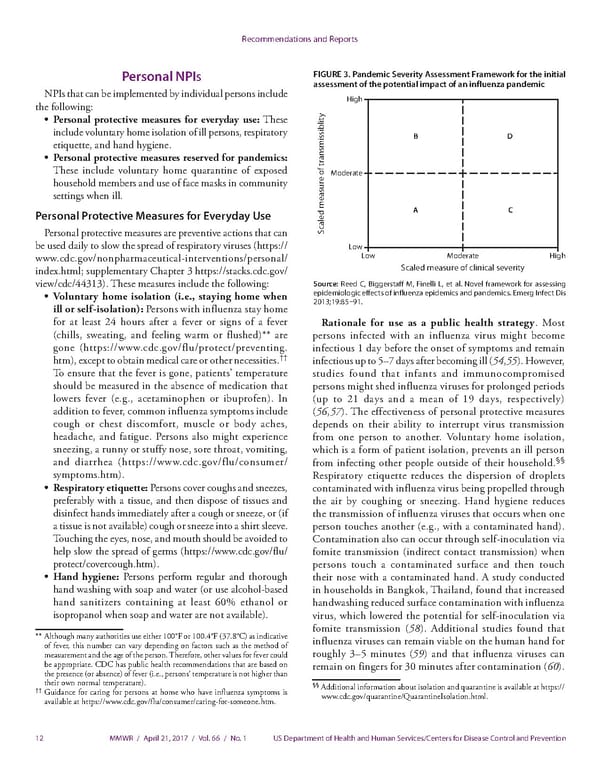Recommendations and Reports Personal NPIS FIGURE 3. Pandemic Severity Assessment Framework for the initial assessment of the potential impact of an influenza pandemic NPIs that can be implemented by individual persons include High the following: y • Personal protective measures for everyday use: These include voluntary home isolation of ill persons, respiratory B D etiquette, and hand hygiene. • Personal protective measures reserved for pandemics: ansmissiblit These include voluntary home quarantine of exposed Moderate household members and use of face masks in community e of tr settings when ill. Personal Protective Measures for Everyday Use A C caled measur Personal protective measures are preventive actions that can S be used daily to slow the spread of respiratory viruses (https:// Low www.cdc.gov/nonpharmaceutical-interventions/personal/ Low Moderate High index.html; supplementary Chapter 3 https://stacks.cdc.gov/ Scaled measure of clinical severity view/cdc/44313). These measures include the following: Source: Reed C, Biggerstaff M, Finelli L, et al. Novel framework for assessing • Voluntary home isolation (i.e., staying home when epidemiologic effects of influenza epidemics and pandemics. Emerg Infect Dis 2013;19:85–91. ill or self-isolation): Persons with influenza stay home for at least 24 hours after a fever or signs of a fever Rationale for use as a public health strategy. Most (chills, sweating, and feeling warm or flushed)** are persons infected with an influenza virus might become gone (https://www.cdc.gov/flu/protect/preventing. infectious 1 day before the onset of symptoms and remain †† htm), except to obtain medical care or other necessities. infectious up to 5–7 days after becoming ill (54,55). However, To ensure that the fever is gone, patients’ temperature studies found that infants and immunocompromised should be measured in the absence of medication that persons might shed influenza viruses for prolonged periods lowers fever (e.g., acetaminophen or ibuprofen). In (up to 21 days and a mean of 19 days, respectively) addition to fever, common influenza symptoms include (56,57). The effectiveness of personal protective measures cough or chest discomfort, muscle or body aches, depends on their ability to interrupt virus transmission headache, and fatigue. Persons also might experience from one person to another. Voluntary home isolation, sneezing, a runny or stuffy nose, sore throat, vomiting, which is a form of patient isolation, prevents an ill person and diarrhea (https://www.cdc.gov/flu/consumer/ §§ from infecting other people outside of their household. symptoms.htm). Respiratory etiquette reduces the dispersion of droplets • Respiratory etiquette: Persons cover coughs and sneezes, contaminated with influenza virus being propelled through preferably with a tissue, and then dispose of tissues and the air by coughing or sneezing. Hand hygiene reduces disinfect hands immediately after a cough or sneeze, or (if the transmission of influenza viruses that occurs when one a tissue is not available) cough or sneeze into a shirt sleeve. person touches another (e.g., with a contaminated hand). Touching the eyes, nose, and mouth should be avoided to Contamination also can occur through self-inoculation via help slow the spread of germs (https://www.cdc.gov/flu/ fomite transmission (indirect contact transmission) when protect/covercough.htm). persons touch a contaminated surface and then touch • Hand hygiene: Persons perform regular and thorough their nose with a contaminated hand. A study conducted hand washing with soap and water (or use alcohol-based in households in Bangkok, Thailand, found that increased hand sanitizers containing at least 60% ethanol or handwashing reduced surface contamination with influenza isopropanol when soap and water are not available). virus, which lowered the potential for self-inoculation via fomite transmission (58). Additional studies found that ** Although many authorities use either 100°F or 100.4°F (37.8°C) as indicative influenza viruses can remain viable on the human hand for of fever, this number can vary depending on factors such as the method of measurement and the age of the person. Therefore, other values for fever could roughly 3–5 minutes (59) and that influenza viruses can be appropriate. CDC has public health recommendations that are based on remain on fingers for 30 minutes after contamination (60). the presence (or absence) of fever (i.e., persons’ temperature is not higher than their own normal temperature). §§ †† Additional information about isolation and quarantine is available at https:// Guidance for caring for persons at home who have influenza symptoms is www.cdc.gov/quarantine/QuarantineIsolation.html. available at https://www.cdc.gov/flu/consumer/caring-for-someone.htm. 12 MMWR / April 21, 2017 / Vol. 66 / No. 1 US Department of Health and Human Services/Centers for Disease Control and Prevention
 Community Mitigation Guidelines to Prevent Pandemic Influenza Page 13 Page 15
Community Mitigation Guidelines to Prevent Pandemic Influenza Page 13 Page 15